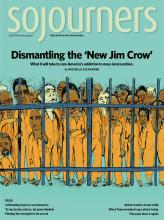FRANCISCAN BROTHER ROBERT LENTZ is a contradictory blend of traditional and tradition-challenging. That same surprising mix could be said to typify his contemporary approach to the ancient art of iconography.
Brother Robert’s work adorns cathedrals, churches, and homes of many faiths, though his name may not ring a bell, even among his fans.
But describe his icons of Martin Luther King Jr. or César Chávez, his portrayals of Jesus as black, Korean, and Navajo, and his non-Christian subjects including Mohandas Gandhi and the Sufi mystic Rumi, and the response may be “Oh, yes! I have one of those.”
Icons—religious paintings used as aids in Christian prayer—have been called a “doorway into the kingdom of heaven.” Brother Robert’s icons are striking, often for the contemporary twists in classically structured images, such as the army canteen held by St. Toribio Romo, a 20th century Mexican priest who is revered as the patron of migrants crossing the border. His Chávez image carries a copy of the Constitution and wears a sweatshirt with the United Farmworkers logo. “Icons may contain anachronisms,” he said, “when there is a great truth at stake.”
Brother Robert’s work—and his life—seem often to focus on such anachronisms in pursuit of truth. At 67, he is a Roman Catholic Franciscan brother in the New York-based Holy Name Province, living and working in a studio created for him in the order’s seminary near Washington, D.C. A religious brother is not a priest, though he lives by the vows of poverty, chastity, and obedience and dedicates his life to charitable service. It’s Brother Robert’s second stretch as a Franciscan, the order founded by St. Francis of Assisi. But it’s his third stint in religious life, having also come close to ordination as a priest in the Russian Orthodox Church Outside of Russia.
Read the Full Article
